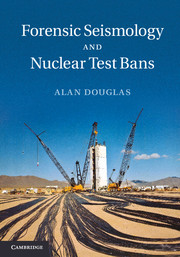Book contents
- Frontmatter
- Contents
- Preface
- Abbreviations and mathematical symbols
- Prologue
- 1 Seismology: ancient and modern
- 2 Statistical solutions to seismological problems
- 3 Seismograms as time series
- 4 Seismographs and seismograms
- 5 Seismometer arrays and processing methods
- 6 Seismogram interpretation and synthesis
- 7 Hypocentres and P travel times
- 8 Seismic magnitudes
- 9 Seismic source identification
- 10 Epilogue
- Appendix A P and S radiation from a double-couple source
- Appendix B Normal equations for analysis of variance
- Appendix C Some uses of the FFT
- Appendix D Anelastic attenuation
- Appendix E The relation of the transient and steady-state responses
- Appendix F Seismometer–galvanometer systems
- Appendix G SNI from summing array recordings
- Appendix H The equations for computing MP filters
- Appendix I Circular arrays
- Appendix J Geometrical spreading when S reflects as sP
- Appendix K The Fourier integral for a dispersed wave train
- Appendix L Tables of explosions and earthquakes
- Appendix M Album of body-wave seismograms
- Appendix N Exercises
- References
- Further reading
- Author index
- Index
4 - Seismographs and seismograms
Published online by Cambridge University Press: 05 March 2013
- Frontmatter
- Contents
- Preface
- Abbreviations and mathematical symbols
- Prologue
- 1 Seismology: ancient and modern
- 2 Statistical solutions to seismological problems
- 3 Seismograms as time series
- 4 Seismographs and seismograms
- 5 Seismometer arrays and processing methods
- 6 Seismogram interpretation and synthesis
- 7 Hypocentres and P travel times
- 8 Seismic magnitudes
- 9 Seismic source identification
- 10 Epilogue
- Appendix A P and S radiation from a double-couple source
- Appendix B Normal equations for analysis of variance
- Appendix C Some uses of the FFT
- Appendix D Anelastic attenuation
- Appendix E The relation of the transient and steady-state responses
- Appendix F Seismometer–galvanometer systems
- Appendix G SNI from summing array recordings
- Appendix H The equations for computing MP filters
- Appendix I Circular arrays
- Appendix J Geometrical spreading when S reflects as sP
- Appendix K The Fourier integral for a dispersed wave train
- Appendix L Tables of explosions and earthquakes
- Appendix M Album of body-wave seismograms
- Appendix N Exercises
- References
- Further reading
- Author index
- Index
Summary
Nothing happens until something moves.
(Albert Einstein)Introduction
As all seismograms are filtered versions of ground motion they cannot be interpreted without knowing the filter response. Analysts will know roughly from simple inspection of a seismogram how the ground motion has been filtered when the response is unspecified: LP seismograms show quasi-sinusoidal signals with a period of a few tens of seconds; SP seismograms often show signals as wavelets of ˜ s period and broad-band signals may be pulse-like. The effect is illustrated with synthetic seismograms in Figure 4.1 for amplitude responses shown in Figure 4.2. For quantitative interpretation and analysis, the response must be known.
The original way of specifying the response of a seismograph was from its natural frequency and damping. For modern systems which have additional filters amore systematic and convenient way of specifying the response is required. Following Bogert (1961), AWE Blacknest adopted the use of what are called the poles and zeros of the system from which the amplitude and phase response as a function of frequency, and hence the impulse response, can be generated. Almost all modern seismological systems are specified in this way.
Because many observatories are in regions of high man-made (cultural) noise, SP systems are usually bandpass filters rather than high pass. The WWSSN SP system shown in Figure 4.2 is an example. Such narrow-band systems are of little value except for observations of onset times and station magnitudes.
- Type
- Chapter
- Information
- Forensic Seismology and Nuclear Test Bans , pp. 121 - 167Publisher: Cambridge University PressPrint publication year: 2013



